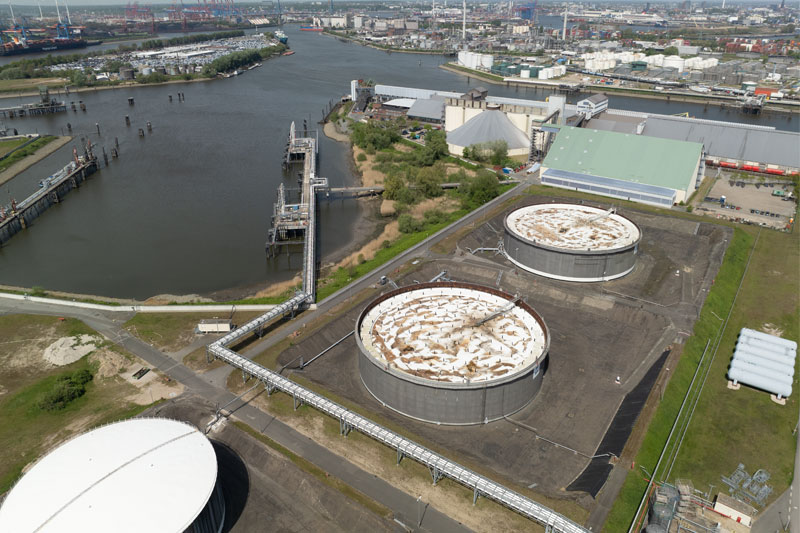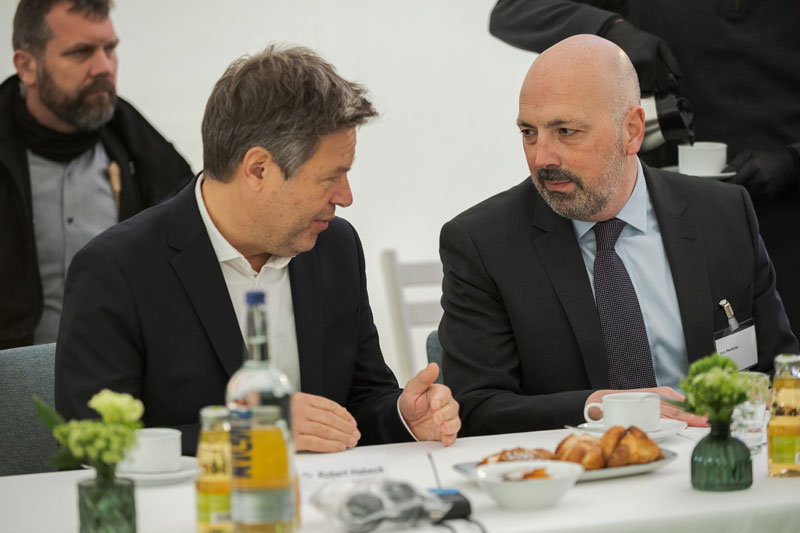“Funding is crucial”
The ramp-up of the hydrogen economy in Hamburg can begin. The Hamburg Green Energy Hub project is receiving significant funding from the German federal ...

By Ralf Johanning
Ammonia as a source of energy is still a hidden champion in the implementation of decarbonisation. But that could soon change. Compared to hydrogen, ammonia is easier and less expensive to transport and store. For decades, tankers have been used to transport it. For industry, as a fuel for shipping and ultimately for the energy sector, this makes ammonia an interesting option. Ammonia is therefore becoming an important building block for storing and transporting clean energy.
Mabanaft has recognised this trend and intends to implement it in the Port of Hamburg. The company plans to build an ammonia import terminal at the existing Blumensand tank terminal. The company announced this in the presence of the Federal Minister of Economic Affairs, Dr Robert Habeck, and Hamburg’s First Mayor, Dr Peter Tschentscher, back at the end of 2022.
“With the import terminal in the Port of Hamburg, we have the opportunity to implement a further part of the energy transition and to bring it to Hamburg. Through our import terminal, we aim to enable innovative energy solutions such as ammonia for shipping and its processing into hydrogen,” says Philipp Kroepels, Director for New Energy at Mabanaft.
"We aim to
enable innovative
energy
solutions."Philipp Kroepels
Director New Energy bei Mabanaft
Hamburg was not chosen by chance. The site provides strategic access to green ammonia from large-scale green hydrogen production plants operated by Air Products and its partners around the world, among others. The customer, Air Products, is planning to build a hydrogen production plant in the immediate vicinity, which will be used to separate the ammonia into hydrogen and nitrogen and prepare it for distribution. Mabanaft’s goal is to supply ammonia to these customers locally, but also throughout northern Germany.

According to Mabanaft, the project will require some construction and modification work. Among other things, two large tanks for mineral oil at the terminal will have to be demolished. A tank for the interim storage of imported ammonia will then be built there.
But before it can begin, the company needs permission from Hamburg’s Authority for the Environment, Climate, Energy and Agriculture (BUKEA). Other departments and authorities are also involved in the project. The Hamburg Port Authority (HPA), the Waterways and Shipping Administration (WSV), the building authorities, the State Office for Mining, Energy and Geology (LBEG), the fire brigade and the environmental protection associations will all be consulted. “We successfully submitted the application for our New Energy Gate Hamburg at the beginning of July and would like to see the process completed swiftly and successfully,” emphasises Kroepels.

At the invitation of Hamburg’s Authority for the Environment, Climate, Energy and Agriculture (BUKEA), Mabanaft participated in a scoping meeting to prepare for the construction of an ammonia terminal. At this meeting with representatives of BUKEA and other parties, the participants defined the scope of the voluntary environmental impact assessment, identified the documents to be submitted and defined a 2,500-metre radius around the proposed terminal.

Mabanaft is paying special attention to the toxic effects of ammonia and to the handling of cold storage at a temperature of -33 degrees Celsius. The company wants to rule out any incidents and is therefore planning various redundant safety measures. These include a double steel tank with an additional concrete outer safety shell and an in-port transhipment facility that complies with the recognised rules of technology. In addition, the terminal will be staffed 24 hours a day by suitably trained operators and emergency first-aiders for emergencies.
“As a company with a focus on sustainability, it was important to us from the outset to be as transparent as possible in our approach,” emphasises Kroepels. For the company, it will be essential to take into account and cumulatively consider the protected assets within the radius in terms of flora, fauna and biodiversity. These include the soil and the land, the water, the climate and the air, the landscape, the cultural heritage and other material assets.
If all goes according to plan, Mabanaft plans to commission Germany’s first ammonia import terminal in 2027. This project is an important step towards decarbonisation and underlines the company’s commitment to sustainability and safety.